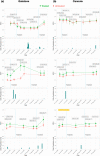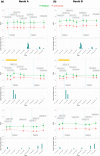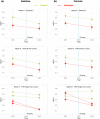Satellite monitoring of bio-fertilizer restoration in olive groves affected by Xylella fastidiosa subsp. pauca
- PMID: 37029149
- PMCID: PMC10082035
- DOI: 10.1038/s41598-023-32170-x
Satellite monitoring of bio-fertilizer restoration in olive groves affected by Xylella fastidiosa subsp. pauca
Abstract
Xylella fastidiosa subsp. pauca (Xfp), has attacked the olive trees in Southern Italy with severe impacts on the olive agro-ecosystem. To reduce both the Xfp cell concentration and the disease symptom, a bio-fertilizer restoration technique has been used. Our study applied multi-resolution satellite data to evaluate the effectiveness of such technique at both field and tree scale. For field scale, a time series of High Resolution (HR) Sentinel-2 images, acquired in the months of July and August from 2015 to 2020, was employed. First, four spectral indices from treated and untreated fields were compared. Then, their trends were correlated to meteo-events. For tree-scale, Very High Resolution (VHR) Pléiades images were selected at the closest dates of the Sentinel-2 data to investigate the response to treatments of each different cultivar. All indices from HR and VHR images were higher in treated fields than in those untreated. The analysis of VHR indices revealed that Oliarola Salentina can respond better to treatments than Leccino and Cellina cultivars. All findings were in agreement with in-field PCR results. Hence, HR data could be used to evaluate plant conditions at field level after treatments, while VHR imagery could be used to optimize treatment doses per cultivar.
© 2023. The Author(s).
Conflict of interest statement
The authors declare no competing interests.
Figures















References
-
- Saponari M, Boscia D, Nigro F, Martelli GP. Identification of DNA sequences related to Xylella fastidiosa in oleander, almond and olive trees exhibiting leaf scorch symptoms in Apulia (Southern Italy) J. Plant Pathol. 2013;95:668. doi: 10.4454/JPP.V9513.035. - DOI
-
- Cariddi C, Saponari M, Boscia D, De Stradis A, Loconsole G, Nigro F, Porcelli F, Potere O, Martelli GP. Isolation of Xylella fastidiosa strain infecting olive and oleander in Apulia, Italy. J. Plant Pathol. 2014;96:425–429. doi: 10.4454/JPP.V9612.024. - DOI
-
- Scortichini M. The epidemiology and control of “olive quick syndrome” in Salento (Apulia, Italy) Agronomy. 2022;12:2475. doi: 10.3390/agronomy12102475. - DOI
-
- Martelli GP. The current status of the quick decline syndrome of olive in Southern Italy. Phytoparasitica. 2016;44:1–10. doi: 10.1007/s12600-015-0498-6. - DOI
MeSH terms
Substances
Supplementary concepts
LinkOut - more resources
Full Text Sources

